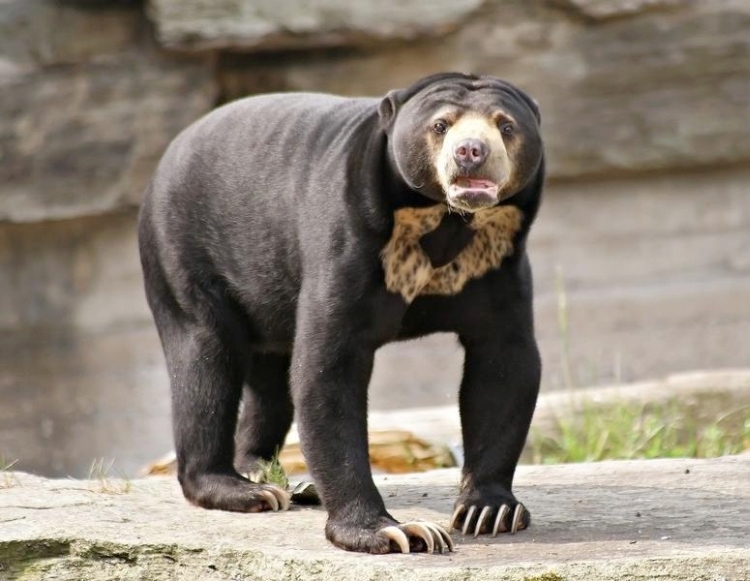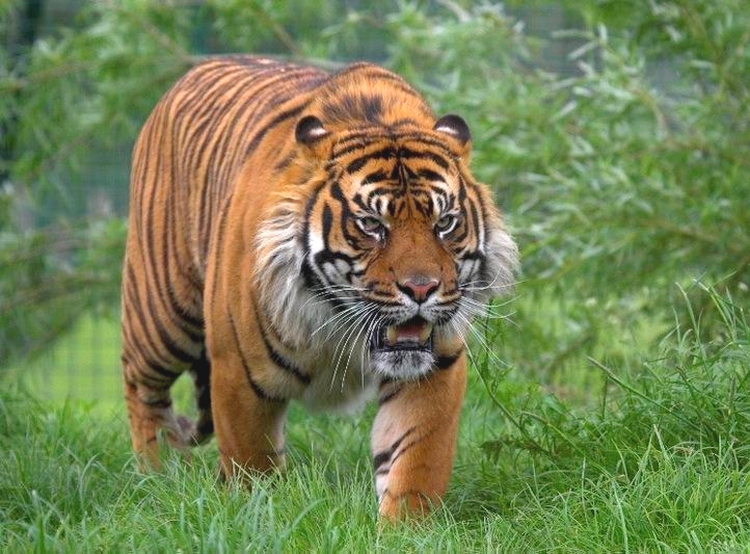|
|
Post by sarus on Dec 8, 2011 5:36:59 GMT -9
 [blue] Sun Bear (Ursus malayanus)[/blue]  [blue] Tiger (Panthera tigris)[/blue] |
|
Deleted
Deleted Member
Posts: 0
|
Post by Deleted on Dec 8, 2011 17:11:41 GMT -9
There are accounts that say the sun bear is the smallest but the meanest bear and has loose skin on its neck which makes it capable of turning around and biting back at its predator (e.g.tiger - one of the smallest subspecies).
However, there are other accounts that say the sun bear' aggression is overrated given the fact it being more aboreal than the sloth bear would rather climb than fight and that is a similar situation when comparing black bears and brown bears.
Here are some quotes from The Great Bear Almanac, by Gary Brown, on the Sun Bear:
|
|
|
|
Post by sarus on Dec 9, 2011 1:24:51 GMT -9
 Account of a battle between two sun bears and "some" Sumatran tigers over durians (fruit).- - -* Dutch (transcription):UIT DE MAILBLADEN.Strijd in de dierenwerelden. Account of a battle between two sun bears and "some" Sumatran tigers over durians (fruit).- - -* Dutch (transcription):UIT DE MAILBLADEN.Strijd in de dierenwerelden.
Veldslag tusschen tijgers en beren.Inlandsche opnemers hebber dezen dagen een spannende ontmoeting gehad, terwijl ze in het bosch in de nabijheid van het kolonisatieterrein Metro in de Lampung aan het werk waren. Plotseling opgeschrikt door een hevig kabaal, zagen ze op een goede honderd meter afstand eenige tijgers met twee beren een volledigen veldslag leveren. Er staat daar op dier plek een wilde doerian-boom, waar beide soorten dieren geweldige liefhebbers van zijn en nu elkander de vruchten ervan betwisten. Daar de mantris slechts met een revolver gewapend waren, hebben ze den uitslag van het gevecht maar niet afgewatch en vlug veiliger oorden opgezocht, aldus meldt het "Pal. NDLB". - - -* Portuguese translation:"Agentes" coloniais holandeses e vários nativos testemunharam uma excitante cena enquanto trabalhavam numa floresta próxima ao assentamento de Metro(?), na província de Lampung (extremo sul da ilha de Sumatra, Indonésia). Enquanto trabalhavam, a atenção dos homens foi subitamente atraída por ruídos altos provenientes da floresta. Alguns tigres e dois ursos estavam engajados em uma furiosa batalha a apenas uns 100 metros de onde os homens estavam. Os animais foram avistados numa área sombreada por árvores de durião, cujos frutos são apreciados tanto pelos tigres quanto pelos ursos, e ambas as espécies estavam lá em disputa pelo sítio de alimentação. Como os nativos estavam no momento com apenas um revólver, todos rapidamente se refugiaram em locais seguros nas proximidades, de onde pretendiam ver o desenrolar e o resultado da batalha. - - -* English translation:From the mail leaves. Struggle in the animal worlds. Battle between tigers and bears. Native agent sensors these days had an exciting encounter, while in the forest near the settlement site in the Metro Lampung (Sumatra Island, Indonesia) were at work. Suddenly startled by a loud noise, they saw a good few hundred yards with two tigers bears deliver a full battle. There's a spot there on animal-wild durian tree, where both kinds of animals are great fans of each other and now reap their dispute. As the only natives were armed with a revolver, they are the outcome of the battle but not yet watch and quickly sought safer places, according to reports the "Pal. NDLB". - Because of my limited skills in English I am not able to "polish" this automatic translation, but certainly someone else can do this task easily.- - -Source:De Gooi- en Eemlander - TUESDAY, MARCH 26, 1940► kranten.kb.nl/view/article/id/ddd%3A010309376%3Ampeg21%3Ap010%3Aa0239► kranten.kb.nl/view/pdf/id/ddd%3A010309376%3Ampeg21%3Ap010%3Aa0239 (download of the newspaper - PDF format)- - -Originally posted on the Brazilian forum "Ursos - Vida Selvagem" by Carlos Guerreiro:► www.orkut.com.br/Main#CommMsgs?cmm=81524761&tid=5665092001279903045 |
|
|
|
Post by sarus on Dec 9, 2011 2:23:59 GMT -9
ACCOUNT OF A DEADLY STRUGGLE BETWEEN A SUN BEAR AND A SUMATRAN TIGER (SUMATRA ISLAND, INDONESIA). TIGER AND BEAR DIED.While nearly all animals have a particular area which they frequent-as the low coast region, the plateaus of these tropical lands, or the higher parts of the mountains-the rhinoceros lives indifferently anywhere between the sea-shores and the tops of the highest peaks. This species has two " horns," the first being the longer and more sharply pointed, but the Java species has only one. The natives here know nothing of the frequent combats between these animals and elephants, that are so frequently pictured in popular works on natural history. The Resident has, however, told me of a combat between two other rivals of these forests that is more remarkable. When he was controleur at a small post, a short distance north of this place, a native came to him one morning, and asked, if he should find a dead tiger and bring its head, whether he would receive the usual bounty given by the government. The Resident assured him that he would, and the native then explained that there had evidently been a battle between two tigers in the woods, near his kampong, for all had heard their howls and cries, and they were fighting so long that, he had no doubt, one was left dead on the spot. A party at once began a hunt for the expected prize, and soon they found the battle had not been between two tigers, as they had supposed, but between a tiger and a bear, and that both were dead. The bear was still hugging the tiger, and the tiger had reached round, and fastened his teeth in the side of the bear's neck. The natives then gathered some rattan, wound it round them, just as they were, strung them to a long bamboo, and brought them to the office of the Resident, who gave a full account of this strange combat in his next official report. These bears are popularly called " sun" bears, Helarctos Malayanus, from their habit of basking in the hot sunshine, while other bears slink away from the full light of day into some shady place. The Resident at Bencoolen had a young cub that was very tame. Its fur was short, fine, and glossy. It was entirely black, except a crescent-shaped spot of white on its breast, which characterizes the species. Source: Travels in the East Indian archipelago (Albert Smith Bickmore)► books.google.com.br/books?id=t3dCAAAAIAAJ&pg=PA510&lpg=PA510&dq=%22but+between+a+tiger+and+a+bear%22&source=bl&ots=4_ddwAclQ9&sig=KBEkMej4XIN33ZNWH0dNXyT3rW0&hl=pt-BR&ei=mevhTtjjB4G2tweP2fX_BA&sa=X&oi=book_result&ct=result&resnum=1&ved=0CB4Q6AEwAA#v=onepage&q=%22but%20between%20a%20tiger%20and%20a%20bear%22&f=false
|
|
|
|
Post by grrraaahhh on Dec 9, 2011 11:14:13 GMT -9
Thanks again sarus. Great information. The online translation software while good are not at all perfect. I am sure in due time satisfactory refinement of translation will happen.
|
|
|
|
Post by warsaw on Dec 9, 2011 15:08:51 GMT -9
Thanks sarus.
|
|
|
|
Post by sarus on Mar 7, 2012 17:41:03 GMT -9
|
|
|
|
Post by sarus on May 12, 2012 6:04:15 GMT -9
|
|
|
|
Post by warsaw on Jun 12, 2012 2:56:53 GMT -9
"...Therefore, I would postulate that the majority of the tiger’s prey consists of pigs and muntjac, 2 of the largest and most locally available prey species, supplemented by whatever else is available as needed. It may be argued that sun bear is not a typical prey for tigers and the evidence in this study merely suggests opportunistic predation. Sun bear was relatively common, second only to muntjac (Table 3-5) and it was also fairly widely distributed at an average estimated occupancy of 62% (Table 3-7), presenting ample opportunities for predation. Campell (1894), Clutterback (1894), and Lane (1904) reported that tigers killed other bear species larger than sun bears. Clearly not all sun bears are vulnerable to predation, but the same can be said for aggressive male wild boar that can weigh up to 127 kg (Khan 1992). The 3 sun bears killed by tigers were adult animals although dentition suggested that 1 was very old..." www.carnivoreconservation.org/files/thesis/khan_2004_phd.pdf |
|
|
|
Post by sarus on Jun 25, 2012 13:11:27 GMT -9
|
|
|
|
Post by sarus on Aug 23, 2017 1:01:50 GMT -9
|
|
|
|
Post by sarus on Dec 15, 2020 1:14:24 GMT -9
|
|